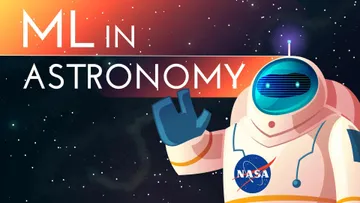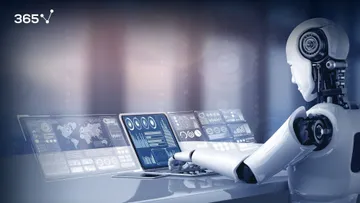You've likely come across terms like AI, ML, neural networks, and deep learning. These buzzwords can be perplexing, even for those of us who work with these topics regularly.
Artificial intelligence (AI) and machine learning (ML), in particular, are often used interchangeably, but they’re distinct concepts with differences in scope and functionality.
This article aims to clarify the difference between AI vs machine learning, exploring their relationship, applications, and impact on various industries.
Table of Contents
- What is Artificial Intelligence?
- What is Machine Learning?
- AI vs Machine Learning: Key Differences
- Subsets of AI
- AI and Machine Learning in Practice
- Generative AI vs Machine Learning
- What is an AI Model vs an ML Model?
- Learn AI and ML with 365 Data Science
- FAQs
What is Artificial Intelligence?
AI is a broad field of computer science focused on creating intelligent machines that can perform tasks that typically require human intelligence. These tasks include, but are not limited to, visual perception, speech recognition, decision-making, and language translation.
AI encompasses a wide range of technologies and approaches, with machine learning being one of its most prominent subsets.
The concept of AI dates back to the 1950s, with the goal of creating machines that can mimic human cognitive functions. Over the years, AI has evolved significantly, leading to the development of various artificial intelligence models and applications that we see today.
For more information on the history of AI, check out our YouTube video!
What is Machine Learning?
One of the most common questions is: Is machine learning AI? The answer is yes, but they are not interchangeable.
Machine Learning, commonly referred to as ML, is a subset of AI that focuses on the development of algorithms and statistical models that enable computer systems to improve their performance on a specific task through experience—in other words, learn from experience.
But what does ML mean in practice? It involves feeding large amounts of data into algorithms that can recognize patterns and use them to make predictions or decisions. This approach has revolutionized many fields, from image and speech recognition to predictive analytics and autonomous vehicles.
AI vs Machine Learning: Key Differences
When discussing AI vs machine learning, it's important to understand this golden rule:
All machine learning is AI, but not all AI is machine learning.
That’s what we mean when we say that ML is a subset of AI.

Here are some key differences between AI vs ML.
Scope
AI encompasses a wide range of approaches and technologies aimed at creating intelligent systems, while ML specifically focuses on statistical algorithms that improve through more data, experience and data analysis.
In simpler terms, AI is like a big toolbox with many tools for making machines smart, while ML is one specific tool in that box that helps machines learn from data and get better at tasks over time.
Functionality
Another key distinction in the comparison of AI vs machine learning is their functions.
AI systems can be designed to perform a wide range of cognitive tasks (e.g., a virtual assistant controlling smart home devices), while ML systems are specifically focused on learning patterns from data to make predictions or decisions (e.g., a recommendation system suggesting movies based on viewing history).
Autonomy
AI systems can be programmed to make decisions autonomously based on predefined rules, while ML systems learn to make decisions based on patterns in data.
Think of it this way: AI is like a chef who can cook various dishes using different techniques (including following recipes), while ML is like a sous chef who specializes in learning and perfecting recipes through repeated practice and data analysis.
Data Dependency
While both AI and ML can benefit from data, ML is inherently data-driven and requires large datasets to function effectively. Some AI approaches, like expert systems, can operate based on predefined rules without requiring extensive data.
Subsets of AI
To further explain the relationship between AI and machine learning, it's helpful to explore the various subsets of AI:

- Machine Learning: As discussed, ML is a subset of AI that focuses on enabling systems to learn from data using statistical methods and algorithms.
- Deep Learning: A subset of machine learning that uses artificial neural networks (ANNs) with multiple layers to analyze various factors of data. ANNs are computing systems inspired by biological neural networks in the brain, consisting of interconnected nodes or "neurons" that process and transmit information.
- Natural Language Processing (NLP): Focuses on the interaction between computers and humans using natural language.
- Computer Vision: Deals with how computers can gain high-level understanding from digital images or videos.
- Robotics: Involves the design, construction, operation, and use of robots.
- Expert Systems: AI systems that emulate the decision-making ability of a human expert.
AI and Machine Learning in Practice
The difference between AI and ML becomes clearer when we look at their practical applications. AI encompasses a wide range of technologies and approaches, while ML focuses specifically on algorithms that improve through experience. Here are some examples:
AI Applications:
- Virtual assistants like Siri or Alexa
- Autonomous vehicles
- Robotics in manufacturing and healthcare
- Game-playing AI (e.g., chess computers)
Machine Learning Applications:
- Recommendation systems (e.g., Netflix, Amazon)
- Fraud detection in financial services
- Image and speech recognition
- Predictive maintenance in industry
Generative AI vs Machine Learning
A recent development in the field of AI is the emergence of generative AI, which has gained significant attention with models like OpenAI’s GPT and DALL-E. Generative AI refers to AI systems that can create new content, such as text, images, or even music.
This raises the question: how does generative AI compare to traditional machine learning?
While both generative AI and machine learning are subsets of artificial intelligence, they differ in their primary functions:
- Machine Learning: Typically focuses on making predictions or classifications based on existing data.
- Generative AI: Aims to create new, original content that didn't exist before.
Generative AI often uses advanced machine learning techniques, such as deep learning and neural networks, but goes beyond traditional ML by not just analyzing existing data, but creating new data or content based on learned patterns.
What is an AI Model vs an ML Model?
Another question that we often receive with reference to machine learning vs AI is: what is an AI model and how does it differ from an ML model?
An AI model refers to the specific implementation of an artificial intelligence algorithm or system. It's the result of training an AI algorithm on a dataset to perform a specific task. AI models can vary greatly in complexity and function, from simple decision trees to complex neural networks.
An ML model, on the other hand, is a specific type of AI model that learns patterns from data to make predictions or decisions. While all ML models are AI models, not all AI models are ML models. Here's a comparison:
AI Models:
- Can include rule-based systems, expert systems, and other non-learning approaches
- May not require training data in some cases (e.g., rule-based systems)
- Can perform a wide range of tasks, including reasoning, problem-solving, and decision-making
- Examples: Expert systems, symbolic AI systems
ML Models:
- Always require training data to learn patterns and make predictions
- Improve their performance over time as they are exposed to more data
- Typically focus on specific tasks like classification, regression, or clustering
- Examples: Decision trees, support vector machines, neural networks
Understanding the difference between AI and machine learning models is crucial when choosing the right approach for a given problem. While ML models excel at learning from data, some AI problems may be better solved using other AI techniques that don't rely on learning from large datasets.
Learn AI and ML with 365 Data Science
While AI and machine learning are often confused, they represent distinct concepts in computer science.
AI is a broad field aimed at creating intelligent machines, while ML is a specific approach within AI that enables systems to learn from data.
Understanding these differences is crucial for anyone interested in or working with these technologies, as they continue to shape our future.
Now that you understand the difference between AI and ML, are you eager to get in on the AI boom? 365 Data Science offers comprehensive courses that will equip you with the skills you need to succeed in this field. Our curriculum includes courses like:
- Intro to AI
- Machine Learning Processes A-Z
- Machine Learning in Python
- Machine Learning Deep Dive: Business Applications and Coding Walkthroughs
- Deep Learning with Tensorflow
- Natural Language Processing
Our hands-on approach sets us apart. You'll tackle real-world projects ranging from music classification to user engagement tracking. With us, you'll build a robust resume and portfolio, paving the way to your dream role in AI and machine learning.
FAQs










